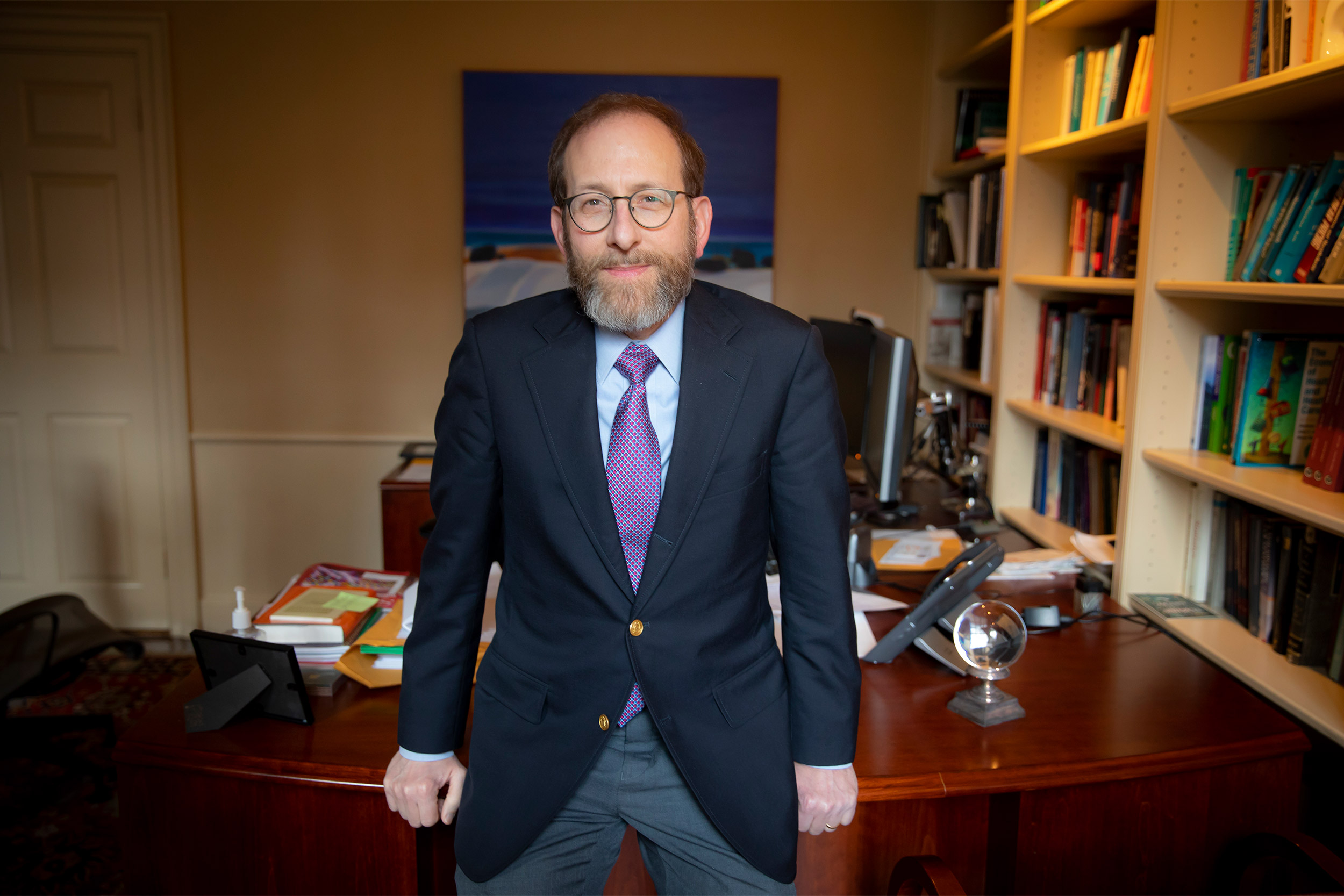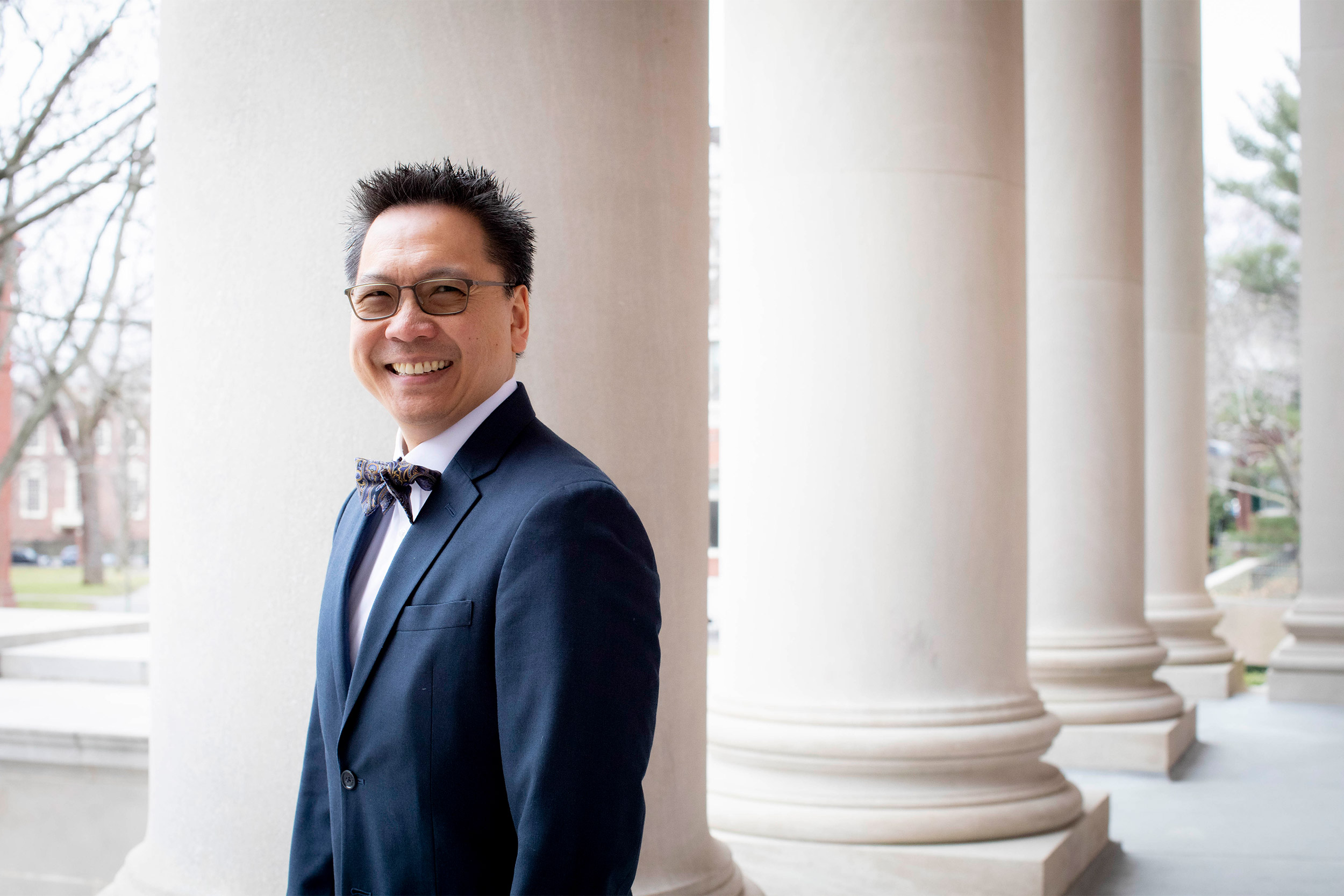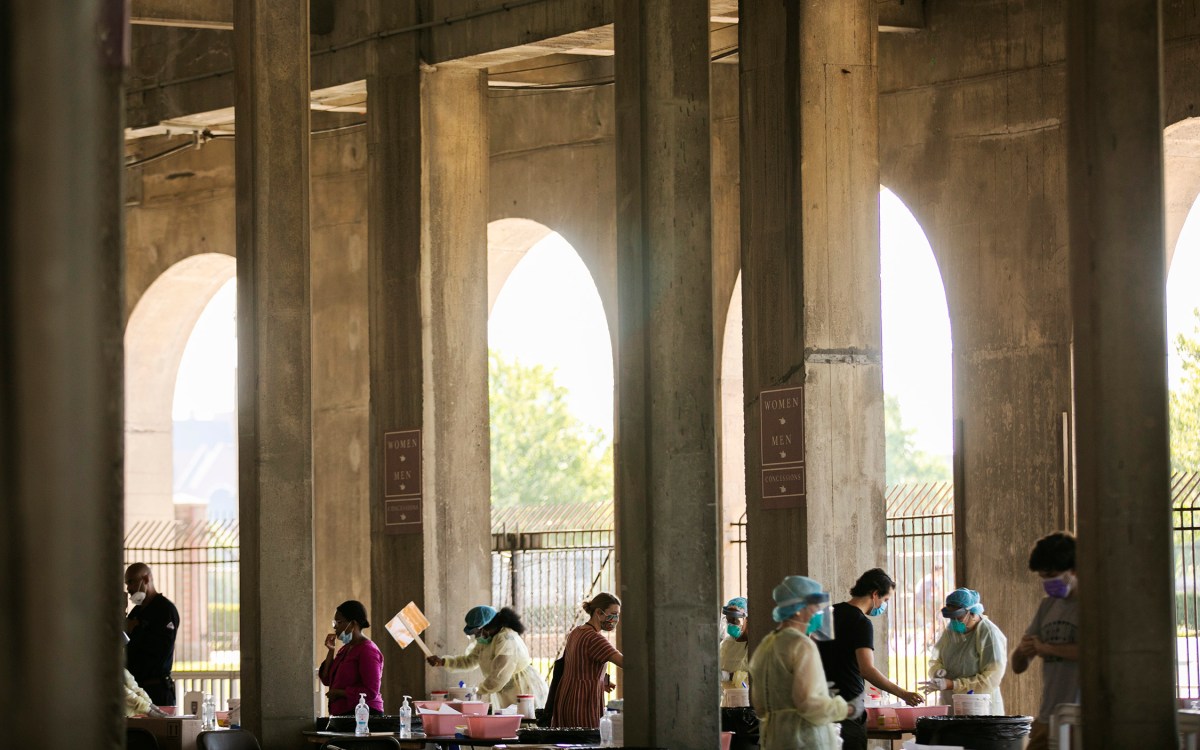
The John Harvard Statue overlooks Harvard Yard.
Stephanie Mitchell/Harvard Staff Photographer
Steps for students returning to campus
Provost and health services director detail protocols, resources
Starting Sunday, Harvard College students will begin to arrive on campus. The residential student body will look different than before; only about 25 percent of undergraduates, primarily first-years, along with a limited number of graduate students, will live on campus, with modifications designed to protect the health of the University community and its neighbors in Cambridge and Boston. Even for those living on campus, all undergraduate instruction, and the majority of graduate instruction, will continue to take place in a virtual setting. The Gazette spoke with Provost Alan M. Garber and Executive Director of Harvard University Health Services (HUHS) Giang Nguyen (both of whom are physicians; Nguyen is also trained in public health) to learn more about what students who have made the decision to live on campus can expect in terms of protocols and resources.
Q&A
Alan Garber and Giang Nguyen
GAZETTE: Could you talk about some of the principles that have guided the University’s planning with regard to bringing people back?
GARBER: With a primary focus on the health and safety of Harvard and surrounding communities, we have invested significant resources into bringing our students, faculty, staff, and academic personnel back safely. Thousands of person-hours have gone into our planning, but we recognize that even the most comprehensive, well-designed efforts will not completely eliminate COVID-related health risks. Of course, everything we do is based on our commitment to fulfilling our core teaching and research mission.
Our community has an opportunity to establish a path toward safe and meaningful campus life during a pandemic. It will not be easy, and we may make mistakes along the way, but if we adhere to community health guidelines and to our core values of safety and academic mission, together we can succeed.

GAZETTE: Key to the plans for reducing risk of exposure to COVID-19 for those living on campus will be regular, required testing. Can you provide an overview of those protocols?
NGUYEN: Regular testing is one of the most important steps we have put in place to ensure that we can monitor the state of the virus on campus and ensure that individuals and the University can take steps to control against, to the greatest extent possible, a widespread outbreak. For those students, faculty, and staff who are living in dorm-style, on-campus housing, we will start with a requirement for testing three times a week. University personnel and other students not living on campus who are authorized to be on campus will also be tested regularly. These self-administered tests currently must be done under clinical observation, but eventually they will not require observation. Until then, students, faculty, and staff living in dorm-style housing will be required to go to one of several testing locations around campus for observed testing. With this frequency of testing, we will be able to detect infections before symptoms emerge, closely monitor infections, and make any necessary decisions to further contain the virus and protect students and other members of our community.
GARBER: Our decision to test frequently was informed by extensive discussions with scientists and public health and medical experts from Harvard-affiliated hospitals, the University, and other universities. Some produced mathematical models of the transmission of COVID-19 in student residences, which they used to assess how nonpharmaceutical interventions like testing programs could help control it. Frequent testing, when accompanied by appropriate quarantine and isolation, is highly effective at limiting the size of any outbreak. Its effectiveness is further reinforced by mask wearing, social distancing, and hand washing. In addition to extensive, frequent screening for viral infection, the number of in-person classes on campus will be very small; all courses at the College are being conducted virtually, as are the vast majority of classes at the University’s graduate schools. This is a vital part of our strategy.
GAZETTE: We’ve already seen outbreaks at colleges and universities that have returned students to campus. How likely is it that some students at Harvard will test positive for the coronavirus, despite all of the precautions put into place?
GARBER: It’s very likely that some will test positive. Based on the numbers of students coming to Harvard and the overall prevalence of the coronavirus nationwide, it’s entirely possible that as many as 50 students would test positive soon after arrival on campus. Most would likely have minimal or no symptoms. We have put the systems in place to prepare for this possibility and many other contingencies.
To begin with, Harvard has sharply limited the number of students who will be on campus. For example, only 40 percent of undergraduate students were invited to campus, and because not everyone accepted, only about 25 percent will be in residence. Across the country, colleges and universities developed a wide variety of plans for the fall. Some of the institutions with outbreaks brought a much larger percentage of students to campus — two-thirds of their student body or even more — than will Harvard.
NGUYEN: In addition to pre-travel communications, our safety protocols engage our students as soon as they set foot on campus. Undergraduate students who are moving to the dormitories are expected to have a test on the day of arrival, and, assuming that test is negative, they will remain in quarantine and have repeat testing until their one-week follow-up test is also negative. Students who test positive will be moved into isolation. Our hope is that we are able to identify people who have COVID-19 quickly, before they are highly infectious and before they have exposed many other people. After identification, we will be able ensure that these students are supported, and that others in the broader community are not subsequently exposed.
Moving forward, we’ll continue to work closely with students to monitor their health. For example, all undergraduate students living on campus must sign Harvard College’s community compact whereby they agree to take a mandatory video training, register their symptoms on a daily basis, undergo required testing regimens, and participate in contract tracing as needed.
GAZETTE: What can community members who are arriving, or returning, to campus do themselves to help mitigate the spread of the coronavirus?
NGUYEN: The things that we do as a community at the very beginning of the semester are very important for our successful reintegration of the campus. Everyone must do their part. Further reopening of the University does not mean that we stop the preventive measures that have helped to dampen the epidemic in Massachusetts so far. We all must adhere to the basic recommendations, such as wearing face coverings when in the presence of other people, physical distancing, and following assigned testing regimens. Harvard’s coronavirus website provides information and resources that every community member should access and understand prior to arriving on campus. Additionally, the University has launched the Keep Harvard Healthy public awareness campaign, which includes posters, banners, digital displays, and other public communications reminding our community members of the steps they must continue to take to help lower risk, whether you are on the Harvard campus or located elsewhere.

GAZETTE: Can you explain how isolation and quarantine will look different in Harvard housing?
NGUYEN: Yes, and it’s important to make this distinction. Quarantine is for people who may have been exposed, while isolation is for folks who have a confirmed infection. All undergraduates living on campus will have single rooms in various residences. As I mentioned, they will be asked to quarantine in those rooms for a week following arrival until they receive a second negative test; moving forward, they will also need to quarantine if they are identified as having a COVID-19 exposure. We have separate buildings designated for those undergraduate students who test positive and must be moved into isolation. These students will have single rooms in these spaces, in addition to a private bathroom, and will receive regular check-ins and monitoring by HUHS and College personnel. We will have the capacity to isolate hundreds of students at a time.
We recognize this will be hard for our first-year students who may be away from home for the first time, and who go into isolation, and we have additional resources in place to support them during this difficult time. These students will have in-person assessments by HUHS clinical staff and daily phone check-ins by HUHS contact tracers. They will also receive outreach from the College to support their social and academic well-being. Many students will be able to continue their studies remotely during the isolation period, but they should also let their academic advisers know whether they feel too sick to do so, as, of course, they will need to concentrate first and foremost on their health. Allowances will be made for students who are unable to attend virtual classes due to illness.
GAZETTE: Is there anything else you would like the Harvard community to know as we start this new academic year?
GARBER: Across the Harvard community, countless people have worked throughout the summer to ensure the health and safety of the students, staff, faculty, and academic personnel who will be on campus this coming semester. Although the course of the coronavirus pandemic has surprised many people and it isn’t possible to eliminate the risk of disease, their efforts have prepared us well. The University will also continue to review and monitor data and trends each day through the semester to ensure that our systems and processes are working effectively. We will also remain in close contact with our peer schools and with local public health officials to ensure that we are working with the most accurate, up-to-date information.
The risk of disease transmission will only be minimized if each of us does our part, too. That will require conscientiousness and a recognition that this community-wide threat can only be managed with a community-wide response. Working together, we can ensure a successful fall semester and more rapid progress toward the full resumption of University activities.







